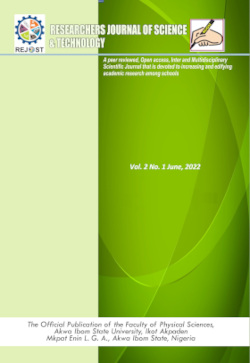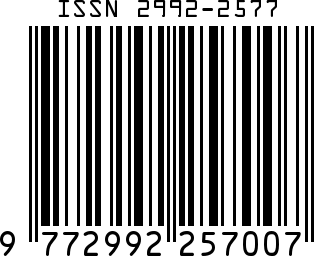Influence of Temperature on Capacitance and Dielectric permittivity of Disc-shaped Compact fabricated from Periwinkle Shell Powder
Keywords:
Cassava starch, Conventional dielectrics, Hausner ratio, Temperature coefficient, WastesAbstract
Periwinkle shells are often generated in large quantities as waste but still remain under-utilised. Prevalently, they are heaped in open fields and landfills. Such disposal method enhances environmental pollution and breeding of disease-carrying organisms, thereby posing severe adverse effects on public health. This research aimed at devising a way to address the problems while deriving benefits from the approach. Periwinkle shells were gathered, washed, dried, and processed into powdery form which then after was blended with a wetting liquid (of viscosity 9.2 x 10-4 Pas, prepared from dry cassava starch). The blended material was utilised to produce five identical disc-shaped compacts used as test samples in this study. Capacitance of the samples was measured at frequencies of 1 kHz, 10 kHz, and 100 kHz over a temperature range of 20 OC to 70 oC. It was observed that, irrespective of the frequency considered, the samples exhibited negative temperature coefficient of capacitance. Also, the dielectric permittivity decreased as frequency increased but ranged in values (4.73 – 9.06), (2.16 – 7.02), and (1.86 – 6.33) within the adopted temperatures limits. Again, it was noticed that the samples could serve as a suitable alternative to conventional dielectrics such as paper, mica, aluminium oxide, and glass which are usually and commonly applied for capacitor manufacturing. Hence, valorisation of Periwinkle shells could serve as a scientific way of solving the associated disposal problems while availing electrical/electronic industries with low-cost, environmentally-friendly, and promising dielectric material suitable for use in capacitive energy storage devices. In the alternative, the samples could be used for electrical insulation in systems designed to operate at temperature that exceeds room value by up to 70 oC.
References
Abdelmalik, A.A., Sadiq, A., (2019). Thermal and electrical characterization of composite metal oxides particles from periwinkle shell for dielectric application. SN Applied Sciences, 1(4); 373, https://doi.org/10.1007/s42452-019-0388-5
Adeniran, A.O., Akankpo, A.O., Etuk, S.E., Robert, U.W., Agbasi. O.E., (2022). Comparative study of electrical resistance of disc-shaped compacts fabricated using calcined clams shell, Periwinkle shell and Oyster shell nanopowder. Kragujevac J. Sci. 44; 25–36, https://doi.org/10.5937/KgJSci2244025A
Aimikhe, V.J., Lekia, G.B., (2021). An overview of the applications of Periwinkle (Tympanotons fascatus) shells. Current Journal of Applied Science and Technology, 40(18); 31 – 58, https://doi.org/10.9734/CJAST/2021/v40i1831442
Aisien, F., Amenaghawon, A.N., Oshomogho, F., (2015). Application of Periwinkle shell ash as photocatalyst in the heterogeneous photocatalytic degradation of aniline in aqueous solution. Journal of Materials and Environmental Science, 6(2), 572 – 579
Anita, M. E., Ajero, I.K., Anih, P.C., (2020). The Effect of Periwinkle shell ash mixed with cement on water absorption and shrinkage of lateritic block. Baltic Journal of Real Estate Economics and Construction Management, 8(1), 22 – 33, https://doi.org/10.2478/bjreecm-2020-0003
Amarachi, N., Gerald, O., Emeka, O., Martin, O., (2021). The Future and Prospects of Periwinkle Composites in Reinforced Concretes: A Review. Journal of Engineering Research and Reports, 21(1): 49-67, https://doi.org/10.9734/JERR/-2021/v21i117439
Badr, A.M., Elshaikh, H.A., Ashraf, I.M., (2011). Impacts of Temperature and Frequency on the Dielectric Properties for insight into the Nature of the Charge Transports in the Tl2S layered single crystals. Journal of Modern Physics, 2(1), Article ID 3764, https://doi.org/10.4236/-jmp.2011.21004
Brindley, K., Carr, J., (2002). Newnes Electronics Engineer’s Pocket Book, 2nd edn., Reed Educational and Professional Publishing Ltd., Johannesburg Melbourne, New Delhi, p. 13, ISBN 0750639725
Dean, J. S., Foeller, P.Y., Reaney, I.M., Sinclair, D.C., (2016). A resource efficient design strategy to optimise the temperature coefficient of capacitance of BaTiO3-based ceramics using finite element modelling. Journal of Materials Chemistry A, 4; 6896 – 6901, https://-doi.org/10.1039/c5ta09573e
Ekop, I. E., Simonyan, K.J., Onwuka, U.N., (2021). Effects of processing factors and conditions on the cracking efficacy of Tympanotonus fuscatus and Pachymelania aurita periwinkles: Response Surface Approach. Journal of Agriculture and Food Research, 3(11), 100094, https://doi.org/10.1016/j.jafr.2020.-100094
Etuk, S.E., Agbasi, O.E., Abdulrazzaq, Z.T., Robert, U.W., (2018). Investigation of thermophysical properties of Alates (swarmers) termites wing as potential raw material for insulation. Int. J. Sci. World, 6(1), 1 – 7, https.//doi.org/10.14419/-ijsw.v6i1.8529
Etuk, S.E., Agbasi, O.E., Ekpo, S.S., Robert, U.W., (2020a). Gamma Radiation determination of absorption coefficients of cement sand block. Cumhuriyet Science Journal, 41(1), 38 – 42, https://dx.doi.org/10.177776/csj.624318
Etuk, S.E., Robert, U.W., Emah, J.B., Agbasi, O.E., (2020b). Dielectric properties of eggshell membrane of some select bird species. Arabian Journal for Science and Engineering, 46(1), 769 – 779, https://doi.org/10.1007/s13369-020-04931-7
Etuk, S.E., Ekpo, S.S., Robert, U.W., Agbasi, O.E., Effiong, E.A., (2022). Dielectric properties of Raphia fiber from Epidermis of young Raphia vinifera leaflet. Acta Technica Jaurinensis, 15(2), 91 – 98, https://doi.org/10.14513/-actatechjaur.00648
Eziefula, U.G., Obiechefu, G.C., Charles, M.E., (2020). Use of Periwinkle shell by-products and Portland cement-based materials: an overview. Intl J Environment and Waste Management, 26(3), 362 – 388, https://doi.org/10.1504/-IJEWM.2020.109165
Halizan, M.Z.M., Mohamed, Z., Yahya, A.K., (2021). Understanding the structural, optical, and dielectric characteristics of SrLaLiTe1−xMnxO6 perovskites. Scientific Reports, 11; 9744, https://doi.org/10.-1038/s41598-021-89132-4
Hart, A., (2020). Mini-review of waste shell-derived materials applications. Waste Management and Research, 38(5); 514 – 527
Iboh, U.A., Robert, U.W., Umoren, G.P., Okorie, U.S., (2020). The effect of frequency variation on dielectric constant of raphia hookerie. Journal of Renewable Energy and Mechanics, 3(2), 53 – 58, https://doi.org/10.25299/rem.2020.vol3(02).4433
Johnnie, E.O., Chituru, A.S., Barine, K.K..D., Joy, E., (2020). Determination of Protein Quality of Oven-dried Clam (Mecerneria in), Whelk (Thias c), Oyster (Crossostrea g.) and Periwinkle (Tympanotonus f.) meat using rat Bioassay. American Journal of Food Science and Technology, 8(5), 172 – 175, https://doi.org/10.12691/ajfst-8-5-1
Kolapo, O., Umoh, A.A., (2012). Strength characteristics of Periwinkle shell ash blended cement concrete. International journal of architecture Engineering and Construction, 1(4), 213 – 220, https://doi.org/10.7492/IJAEC.2012.023
Lebrun, P., Krier, F., Mantanus, J., Grohganz, H., Yang, M., Rozet, E.,Boulanger, B., Evrard, B., Rantanen, J., Hubert, P., (2012). Design space approach in the optimization of the spray-drying process. Eur. J.Pharm. Biopharm. 80; 226–234
Lee, B., Abothu, I.R., Raj, P.M., Yoon, C.K., Tummala, R.R., (2006). Tailoring of temperature coefficient of capacitance (TCC) in nanocomposite capacitors. Scripta Materialia, 54; 1231–1234, https://doi.org/10.1016/j.scriptamat.2005.12.026
Obot, M.U., Yawas, D.S., Aku, S.Y., (2017). Development of an abrasive material using Periwinkle shells. Journal of King Saud University – Engineering Sciences, 29(3), 284 – 288, https://doi.org/10.1016/-j.jksues.2015.10.008
Okorie, U.S., Robert, U.W., Iboh, U.A., Umoren, G.P., (2020). Assessment of the suitability of tiger nut fibre for structural applications. Journal of Renewable Energy and Mechanics, 3(1); 32 – 38, https://doi.org/10.25299/rem.2020.vol3(01).4417
Omisande, L. A., Onugba, M. A., (2020). “Sustainable Concrete Using Periwinkle Shell as Coarse Aggregate – A Review.” IOSR Journal of Mechanical and Civil Engineering (IOSR-JMCE), 17(6); 17 – 22, https://doi.org/10.9790/1684-1706031722
Onuoha, C., (2019). Tribological Behaviour of Periwinkle Shell Powder – filled Recycled Polypropylene Composites. International Journal of Engineering and Technologies, 17, 11 – 20, https://doi.org/10.18052/www.-scipress.com/IJET.17.11
Rahmouni, H., Smari, M., Cherif, B., Dhahri, E., Khirouni, K., (2015).
Conduction mechanism, impedance spectroscopic investigation and dielectric behavior of La0.5Ca0.5-xAgxMnO3 manganites with the composition below the concentration limit ofsilver solubility in perovskites (0≤x≤0.2). Dalton Transactions, 44; 10457 -10466, https://doi.org/10.1039/C5DT00444F
Reddy, R.S., Ramachandra, C.T., Hiregoudar, S., Nidoni, U., Ram, J., Kammar, M., (2014). Influence of processing conditions on functional and reconstitution properties of milk powder made from Osmanabadi goat milk by spray drying. Small Ruminant Research, 119; 130–137, http://dx.doi.org/10.1016/j.-smallrumres.2014.01.013
Robert, U.W., Etuk, S.E., Umoren, G.P., Agbasi, O.E., (2019). Assessment of thermal and mechanical properties of composite board produced from coconut (Cocos nucifera) husks, waste newspapers, and cassava starch. Intl J Thermophys, 40 (9); 83, https://doi.org/10.1007/s10765-019-2547-8
Robert, U.W., Etuk, S.E., Agbasi, O.E., Umoren, G.P., (2020). Comparison of clay soils of different colors existing under same conditions in a location. Imam Journal of Applied Sciences, 5(2), 68 – 73, https://doi.org/10.4103/ijas_35 _ 19
Robert, U.W., Etuk, S.E., Agbasi, O.E., Ekong, S.A., Abdulrazzaq, Z.T., Anonaba, A.U., (2021). Investigation of Thermal and Strength Properties of Composite Panels Fabricated with Plaster of Paris for Insulation in Buildings. Intl J Thermophys., 42(2) 1 -18, https://doi.org/-10.1007/s10765-020-02780-y
Schultz, M.E., (2011). Grob’s Basic Electronics, 11th edn., McGraw-Hill Companies, New York, pp..478, ISBN 978-0-07-122137-5
Ugoeze, K.C., Chukwu, A., (2017). Physico-chemical properties of a modified biomaterial from Tympanotonus fuscata (periwinkle) shell powder considered as pharmaceutical excipient. Journal of Pharmaceutical and Allied sciences, 14(1), 2417 – 2429
Umanah, E.I., Ekpenyong, N.E., Akpan, A.O., (2022). Electrical and dielectric properties of discs fabricated using Periwinkle shell nanopowder and dry cassava starch. Bulletin of the Polytechnic Institute of Iași, 68(72); 1, 7-20, https://doi.org-/10.2478/bipmf-2022-0001
Yawas, D.S., Aku, S.Y., Amaren, S.G., (2016). Morphology and Properties of periwinkle shell asbestos-free brake pad. Journal of King Saud University - Engineering Sciences, 28(1), 103 – 109, http://dx.doi.org/10.1016/j.jksues.2013.11.002

Downloads
Published
How to Cite
Issue
Section
License

This work is licensed under a Creative Commons Attribution-NonCommercial-NoDerivatives 4.0 International License.




